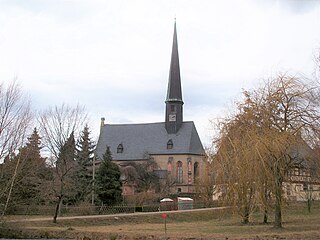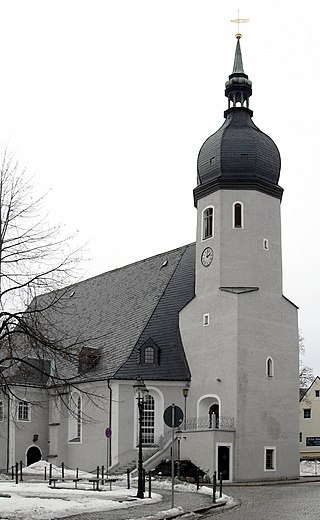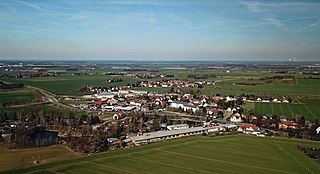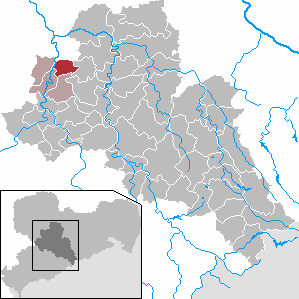
Bad Gottleuba-Berggießhübel is a spa town in the district Sächsische Schweiz-Osterzgebirge in Saxony, in eastern Germany. The municipality borders the Czech Republic in the south. The municipality was formed on 1 January 1999 by the merger of the former municipalities Bad Gottleuba, Berggießhübel, Langenhennersdorf, and Bahratal. Surrounded by forests and near a water dam, Bad Gottleuba-Berggießhübel has several facilities including a spa health park, a plant garden, and a heated open air pool.

Erlau is a municipality in the district of Mittelsachsen in Saxony in Germany. In 1994 it absorbed the former municipalities Beerwalde, Crossen and Schweikershain, and in 1999 Milkau.

Olbernhau is a town in the district Erzgebirgskreis, in Saxony, Germany. It is situated in the Ore Mountains, 35 km southeast of Chemnitz, and 23 km north of Chomutov, Czech Republic.

Elstertrebnitz is a municipality in Saxony, lying southwest of Leipzig and northeast of Zeitz.

Kubschütz (German) or Kubšicy is a municipality in the district of Bautzen, in Saxony, Germany.

Bertsdorf-Hörnitz is a municipality in the Görlitz district, Saxony, Germany.

Großschönau is a municipality in the district Görlitz, in Saxony, Germany located in the cross-border region with the Czech Republic. It used to be a famous Upper Lusatian center of Damask fabric production until the end of the 1980s. Since then it has turned into an area of tourism.

Schönbach is a municipality in the district Görlitz, in Saxony, Germany. It lies very close to the Czech Republic.

Amtsberg is a municipality in the district Erzgebirgskreis, in Saxony, Germany.

Zettlitz is a municipality in the district of Mittelsachsen, in Saxony, Germany.

Boxberg is a municipality in the Görlitz district in Saxony, Germany. The place is known for its large Boxberg Power Station, that uses lignite as fuel.

Groß Düben is a municipality in the district Görlitz, Saxony, Germany.

Horka is a municipality in the district Görlitz, Saxony, in eastern Germany, close to the border with Poland.

Hirschstein is a municipality in the district of Meißen, in Saxony, Germany.
Mittelsachsen is a district (Kreis) in the Free State of Saxony, Germany.

Ebersbach-Neugersdorf is a town in the district of Görlitz, in Saxony, Germany. It is situated on the border with the Czech Republic, just across from the Czech town of Jiříkov. It was formed on 1 January 2011 by the merger of the former municipalities of Ebersbach and Neugersdorf.

Deutscheinsiedel is a village in the Saxon municipality of Deutschneudorf in the district of Erzgebirgskreis in East Germany.
The Pockau-Lengefeld–Neuhausen railway, one of two lines also called the Flöha Valley Railway, is a branch line in the German state of Saxony. It runs in the valley of the Flöha from Pockau via Olbernhau to Neuhausen. Since 2001, the route has been operated by Erzgebirgsbahn, part of Deutsche Bahn's RegioNetz subsidiary.

The Olbernhau-Grünthal–Deutschneudorf railway, also known as Schweinitztalbahn, was a standard gauge branch line in Saxony from Olbernhau to Deutschneudorf in the Ore Mountains. For a short stretch, it also traversed Bohemia. It was opened in 1927 and closed in 1969.

Aue-Bad Schlema is a town and a municipality in the Erzgebirgskreis, in Saxony, Germany. It was created with effect from 1 January 2019 by the merger of the former municipalities of Aue and Bad Schlema.






















